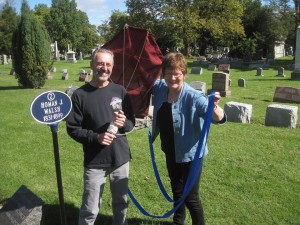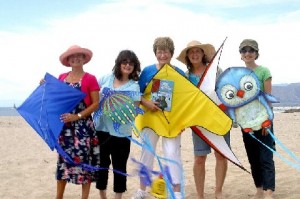The Kite That Bridged Two Nations by Alexis O’Neill, illustrated by Terry Widener (Calkins Creek, 2013)
On January 31, 1848, against tremendous odds, young Homan Walsh flew his kite across the Niagara River, two and half miles north of Niagara Falls. The half-inch cord attached to Homan’s kite became the first line connecting the United States and Canada across the Niagara River, the first step to building the suspension bridge that joined two nations. It’s a fascinating story, beautifully and poetically told by author Alexis O’Neill. ReaderKidZ spoke with Alexis about The Kite That Bridged Two Nations, and the extensive research she undertook to tell Homan’s story.
ReaderKidZ: Your decision to write Homan Walsh’s story as historical fiction was based on some practical realities you encountered as you delved into the research. Can you talk about that decision?
AO’N: Homan Walsh and the kite-flying contest has been part of local lore in Niagara Falls since the 19th century, so his story is well-known. His feat is also listed on kite flying websites as he’s included among the most influential kite fliers in the world. But as I did the research, I realized that what was missing in the factual accounts was the emotion of this historic event. I wanted to shape the existing drama and help readers connect with the awesomeness of Niagara Falls, the joy of flying a kite and the thrill of beating the odds to win a contest that changed history. Historical fiction was the best vehicle for accomplishing this.
 ReaderKidZ: What kinds of things do you feel kids ought to know about research, especially in this day of Wikipedia and the reality that not everything one finds on the Internet is true?
ReaderKidZ: What kinds of things do you feel kids ought to know about research, especially in this day of Wikipedia and the reality that not everything one finds on the Internet is true?
AO’N:There’s nothing wrong with getting an overview of an event through Wikipedia. I begin there myself! But it should be seen as a jumping-off point, never as the final authority on the subject. All researchers – kids as well as adults – need to question everything they read. They need to compare accounts and examine the discrepancies. They need to be aware that just because three sources tell the same “fact,” the authors of those sources might have all used the same book for that “fact” and are just passing along incorrect information. In my Kite book, I corrected three “facts” that were repeatedly reported incorrectly in other books and on websites: Homan’s age at the time of the contest, the amount of money he won as a prize, and who sheltered Homan when he was stranded in Canada for eight days. I spent forever verifying all of this!
ReaderKidZ: I love your Author’s Note at the back of the book and especially how you’ve included sections titled: “What We Know,” “What We Don’t Know,” and “The Rest of the Story.” How might this serve as a template for teachers in helping their students understand the genre of historical fiction?
AO’N:Thanks! I’m happy that you like the back matter! I included those sections because readers will often accept historical fiction as fact. I wanted to help readers separate fact from fiction in this story. The more they are aware of the difference, the more they will keep their antennae up when they read other works of historical fiction. I hope they might begin to ask, “How could this be verified? Is there proof that this person really said or did that? Is the source of that information reliable?” 
Now here’s a bit of an embarrassment. My Kite book was recently reviewed in School Library Journal and placed in the Nonfiction section! But if a writer makes up even one teeny, tiny thing that can’t be verified (a piece of dialogue, a neighbor’s name, an emotional reaction), the piece becomes fiction. Nonfiction means that everything is verifiable. But librarians struggle with this, especially if the book has biographical information in it. They want to place the book where readers are most likely to search for it, so I understand why SLJ did this.
ReaderKidZ: You chose to tell this story in first person. How did you settle on that decision and what was your process in searching for Homan’s voice?
I tried many voices before settling on Homan’s point of view. I tried the story from the point of view of the kite. The falls. The ferry. And then I began thinking about Homan. He had a reputation of being the best kite flier in Niagara Falls. Kite fliers are an amazing breed of people – dedicated, curious, joyful, experimental, smart – and I wanted to express that. But the only recorded interview with Homan, done in 1898, was very flat. It was done a year before he died, so he was recalling an event that had happened 51 years prior. It was his only claim to fame, so his story had a rehearsed quality to it. I wanted to get to the emotion of kite flying, the emotion of seeming to lose all then finally succeeding, the emotion of what it feels like to be a solitary figure in a struggle with awesome wonders of nature, Niagara Falls and the Niagara River Gorge. That’s why I chose to do this story as historical fiction, so I could get to all of that and help a reader connect to what Homan might have felt during this historic contest.
ReaderKidZ: Anything else about the research process or writing historical fiction that you’d like to share with young readers?
AO’N:Document your sources as you find them – no matter how slight they are. Keep whatever you gather in an accessible location (I have dedicated folders on my computer and a project box that I keep in my office for materials and books I collect.) You never know what will be useful later as you shape your work.
One last thing. I recently discovered a pile of reports I had done in junior high and high school that my mom had saved. The subjects included the Alamo (POV of a male survivor), the Spanish Armada (POV of two Cockney sailors), scientist Sir William Thomson (POV his younger brother), and author Washington Irving (POV of a disapproving neighbor). I had written each as historical fiction, and my teachers loved them! So it looks like I’ve been doing this for a very long time.











I think with the Common Core it’s really important for kids to be able to discern, on their own, fiction versus nonfiction. I too love that you have made it so easy in your book, Alexis. I think the POV gives us clues too. If the Falls were to be telling the story, it would have to be historical fiction. First person makes it tough to be 100% nonfiction too, since it’s hard to see into a characters head even with the best of research. Thanks for liberating us from black and white categories, Alexis, and helping us remember that story comes first.
Thanks for your comments, Kirsten. Actually, it is indeed possible to write a first-person narrative (other than autobiography) and have it be 100% nonfiction, and that’s through letters, interviews or speeches by the subject. It’s challenging but not impossible!
Fascinating post. Thank you for expressing the differences between historical fiction and non fiction so clearly, and stressing the importance of documentation! Ah those pesky – but significant – discrepancies!
Interesting. Congrats, Alexis O!
Thanks, Cathy and Michelle. Yes – documentation is important! And if you get in the habit of recording where the source info comes from, you’ll always be in good shape when an editor asks you to support what you’ve written (which, if they are good editors, they will do!)
Great interview. Alexis, I loved watching your school visit a couple of weeks ago. And I just love this book.
Alexis, I loved learning about your journey to write this book…trying out different voices, researching and CORRECTING the “facts,” and also your passion for keeping nonfiction nonfiction. Big huge congratulations! And also for being the SCBWI member of the year. You rock!
Hi Laurisa! I was happy to see you at La Crescenta School. The Assistance League of Glendale does a terrific job of promoting reading and connecting kids with authors. They bring in four authors to five schools each year and fundraise to give the school library a check for $1500 to buy books. Those women are angels. I hope you had a chance to make the rounds and see the other three authors, too. Good luck with your new release!